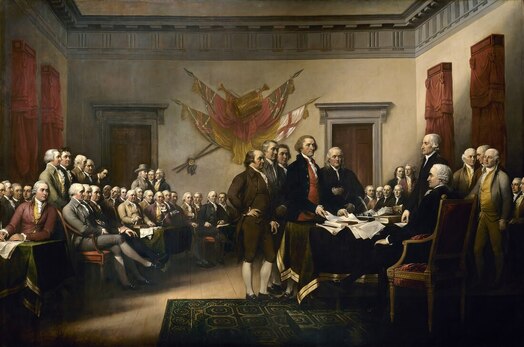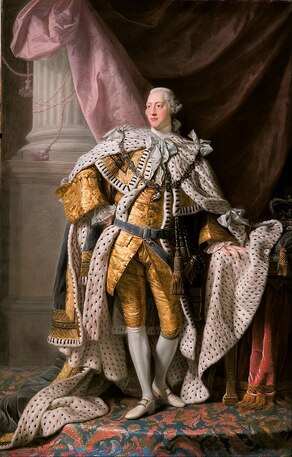1) Probably the most iconic image of American Independence ever … features loads of British flags in the background!The famous painting entitled ‘Declaration of Independence’ was by the American artist John Trumbull. This image - which featured on the $2 Dollar Bill - was not actually commissioned until 1817, some 41 years after the actual ‘Declaration of Independence’ came into effect. Incidentally, the painting does not depict the ‘declaration’ element of 4 July 1776 at all. Rather, it shows the presentation of the draft document to the Continental Congress for consideration prior to signing. Here is another surprise: if one looks at the wall behind the draftees, a collection of British flags is visible, including the King’s Colours - the forerunner of the Union Jack - the very flag that represented the Monarch (George III) that the signatories were declaring independence from. 2) 8 of the 56 SIGNATORIES were actually born in Britain. 2 were born in England!It might come as something of a surprise to learn that many of the signatories of the Declaration of Independence had actually celebrated their British connections at one time or another prior to renouncing them. George Washington, for instance, had fought for Britain against the French and their Native American allies during the Seven-Years’ War / French and Indian War 1756-1763, donning the famous British Redcoat. However, perhaps even more surprisingly, two of the signatories were actually born in England, with 8 in total being born in the British Isles. Robert Morris, who is considered to be one of the architects of the American financial system, was born 3000 miles away in Liverpool. Moreover, Button Gwinnett, the second signatory of the Declaration of Independence, was born in the quiet village of Down Hatherley in Gloucestershire, in 1735. 3) The Declaration of Independence cites the actions OF THE BRITISH KING as the reason for the political separation.The most well-known part of the Declaration of Independence is the preamble, with the famous line ‘We hold these Truths to be self-evident, that all Men are created equal, that they are endowed by their Creator with certain unalienable Rights, that among these are Life, Liberty and the pursuit of Happiness …’ which many will have heard recited or quoted. However, the lesser-known, but crucially important second part of the Declaration of Independence includes a long list of grievances against the British King, which would have been longer still if all of Thomas Jefferson’s original recommendations had been upheld. In the minds of the signatories, the list provides evidence for the separation between America and Britain. In total, eighteen of these begin with the word ‘He’, referring squarely and solely to the supposed ills committed by the British King, George III. These grievances include - but are not limited to - King George III’s refusal to pass necessary laws, stationing a large number of British troops in the colonies, obstructing justice, imposing taxes without consent and cutting off trade. Therefore, much of the content of the American Declaration of Independence is actually focused on the alleged tyrannical actions of the British sovereign.
I hope that you found that interesting and thanks for reading. You can check out our Podcast on the causes of American Independence here. Plus, the Podcast on why Britain lost the war that raged until 1783 here. To finish, here is the Podcast with my quick overview on why King George III deserves a more positive appraisal. Happy July 4 and Independence Day to each and all! Patrick @historychappy Co-Editor
0 Comments
Did you know ...The linguistic and cultural exchanges between the British Isles and Germany are nothing new. They have been a key feature of the shared history between the two nations for many, many years. The English language is famous for incorporating words, phrases and inspiration from many others, which is no surprise given her history of prolonged and diverse cultural interactions through the centuries. We at @VersusHistory have already discussed how the English language has absorbed words from Arabic, such as 'Admiral' and 'Loot' from the languages of the Indian Subcontinent. However, how many of these 11 words did you know originated from the German language?!
Angst Delicatessen Fest Hamster Hinterland Noodle Poltergeist Prattle Rucksack Spritz Waltz Perhaps there were some surprises amongst the eleven? In any event, it is always interesting to be reminded of the fact that the English language has evolved over the years by incorporating and innovating! Patrick @VersusHistory |
Categories
All
Archives
April 2024
|





 RSS Feed
RSS Feed